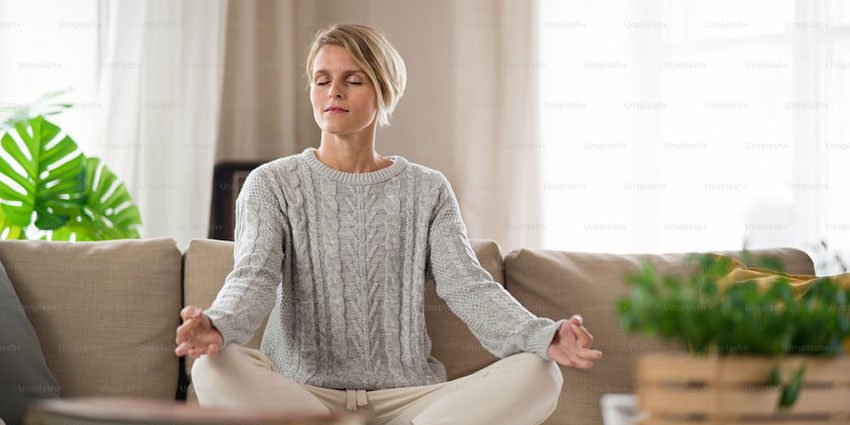Our emotions are reflected on our faces, whether we are sad, happy, or worried… but also in our body, we feel muscular pain or stomachaches, and we may even manifest it more drastically with hair loss, weight gain, or loss…
Lately, I have felt overwhelmed, overrun by my feelings, and my emotions. A series of personal and professional events have shaken my emotional balance. Supposedly, with age, we acquire experience to handle these situations, yet at this stage of my life, instead of better control, I feel like I am on a roller coaster.
As a Yoga teacher, devoted practitioner, and above all, as a woman in this new stage of my life, “GRACE of NO AGE,” I have recently been experiencing the need to change certain routines, including my Yoga practice. My body and mind are urging me to focus on something less physical, something that provides me with greater control and knowledge, allowing me to take care of myself in a more adaptive way to the changes I am experiencing.
Although I have been curious about meditation since a young age, nowadays it has become a necessity to practice daily. However, I acknowledge that I don’t always find it easy to be consistent in this discipline. That is why if you also have that need or curiosity, I encourage you to join me on this journey.
Meditation allows our brain to rest
Meditation is an ancient practice aimed at achieving a state of peace, clarity, and mental balance by using various techniques to enhance concentration. It has also been scientifically proven to help change the structure of the brain and optimize its functioning, delaying its deterioration.
When we are tired, our physical body needs sleep to recover, but the mind, which is like a monkey jumping from one place to another, remains active while we sleep. That is why, when we dream, we move around, and can only experience that rest when we consciously force it to stop. Meditation is the best tool for that.
In meditation, there is no need to have expectations
One of the questions we generally ask ourselves when starting to practice meditation is what we can expect. The answer is simple, “do not expect anything.” The idea is to sit and become an observer, the observer of your own life. Observe what happens physically in your body, and above all, observe what happens in your mind. The objective is to observe without judging, without participating, because thoughts and ideas come and go, just like that, when we don’t try to hold onto or manipulate them.
The emotions or feelings we experience can be positive or negative: happiness, sadness, anger, excitement, frustration, annoyance, envy, acceptance, etc. The reality is that feeling all this is neither good nor bad; it is simply a response to experiences that affect us. What is good or bad is the way we manage those reactions. That is why it is so important to observe what happens to us, accept it, and use the knowledge we gain to motivate ourselves, change, or simply move forward.
In meditation, the main objective is to anchor ourselves in the present moment, in the here and now, which is the only reality that exists. When we dwell too much in the past, sadness overwhelms us, and when we are too obsessed with the future, anxiety floods us. Of course, a bit of both is necessary to learn from our own experiences and to progress in life.
Meditation should be incorporated into our daily routine, just like brushing our teeth, taking a shower, or eating. Developing good mental hygiene also helps us maintain a healthier body.
5 minutes of meditation per day can be enough
And here comes the challenging part: finding the time to sit and observe ourselves, to deal with our own selves. But who can’t spare 5 minutes at any time of the day?
Like everything in life, any practice must start gradually to progress consistently. Here, I will provide you with a small guide to help you get started with meditation:
Meditating for five minutes can be enough
It is important not to set overly ambitious time goals. We can start practicing for 5 minutes and gradually increase the time as we feel comfortable. In the beginning, it is helpful to use a timer to track the time, so we don’t worry about how much time is left or how long we have been meditating.
You can meditate at any time of the day or night.
It is not necessary to meditate at dawn or sunset; any time of the day can be suitable. However, it may be easier in the morning when we haven’t fully engaged with our daily life yet. Therefore, to have a less cluttered mind, it is advisable not to check your phone or the news before sitting down to meditate. The evening might be a quieter time for some other people, but there is also the risk of being too tired and falling asleep.
For beginners, it is easier to meditate in a quiet place
Find a place where you won’t be interrupted, where you can be as peaceful as possible, especially in the beginning, as the mind always seeks excuses to distract itself. With time and practice, we should become capable of meditating and isolating ourselves amidst any circumstances.
Sit down to meditate without expectations
Don’t expect anything
You can meditate while sitting, lying down, or in a chair
Start by adjusting your posture. It is not necessary to sit with a straight back, but it is recommended. We should seek a state of conscious relaxation, being alert, and adopting a posture that helps us stay awake while also being comfortable enough to sit without moving.
Closing the eyes is not necessary for meditation.
Close your eyes if you feel comfortable or keep your gaze fixed on a point.
Focusing on our breath can facilitate meditation
Begin by observing your breath. It is the quickest way to anchor yourself in the present moment. Observe each inhalation and exhalation, and notice the movement it creates in your body: how taking in the air creates space in your shoulders, chest, and abdomen, and how exhaling relaxes the muscles. Practice this for 10 long, conscious breaths.
Use meditation to relax your body
Now, bring your mind’s attention to your physical body. Observe and scan from your feet up to your head, noticing how you are positioned in space, and the contact with the ground, chair, or surface you are on. Observe if there is any particular tension in your body and dedicate a few breaths to gradually release that tension.
Meditate to observe your emotions from the outside
Now, shift your attention to your inner self, your mind, and your emotions. Observe how you are feeling, and what is happening, but just observe it, without giving an opinion or judgment. Imagine you are watching a road filled with vehicles going in all directions, symbolizing your thoughts. You are not part of that traffic; you just watch it from the sidelines.
If at any moment, a thought or emotion overwhelms you, and you get stuck there, return to observing your breath, or visualize an elevator going up and down with the rhythm of your inhalation and exhalation. If you need to readjust your posture any time during the process, do so. Although it is ideal to try not to move, it is better to make adjustments than to get distracted by discomfort.
Using a mantra can help us focus during meditation
Now start repeating the following, as you breathe: Inhale PEACE, exhale LOVE… Inhale PEACE… Exhale LOVE, inhale PEACE… Exhale LOVE (prolong this moment as much as possible).
Return to observing the sensations that repeating these words (mantras) has produced in you. Notice if a feeling of peace and well-being has settled within you.
Gradually exit the meditation. Bring your attention back to your body, starting with your feet and moving up to your head, consciously activating each part. Observe if your body feels more relaxed physically and if any tension you may have accumulated in the beginning has dissipated.
Meditation to anchor ourselves in the present moment and let go of what no longer serves us
Begin to move slowly with gentle movements of your head, hands, legs… And when you’re ready, gradually open your eyes and observe the place where you are. Retain in your mind 3 objects you see, 2 sounds you hear, and 1 scent you perceive. This exercise will help you anchor yourself in the present moment.
And before finishing, mentally place 3 things that no longer serve you (thoughts, emotions…) in a box, close it, and put it away.
Now you’re ready to continue with your day!
Remember that meditation is a completely personal intention and requires time to get used to. It doesn’t matter which technique you use as long as you achieve the goal of controlling what happens in your inner self and giving your mind the necessary rest.
“Yoga for Mental and Physical Health.”
Amparo Hernandez.
Body Health. Meditation. Mental Wellbeing. Yoga Women’s Health.
If you enjoyed this article and would like to help us support this beautiful project so we can continue creating amazing content; please help us by donating as little as the cost of a coffee or as much as you like.
and






